A Comparison of Different Remote Sensors for Ramie Leaf Area Index Estimation
Abstract
:1. Introduction
2. Materials and Methods
2.1. Experimental Design
2.2. Data Collection and Processing
2.2.1. Hyperspectral Data Collection and Processing
2.2.2. Multispectral Data Collection and Processing
2.2.3. Ground LAI Collection
2.3. Correlation Analysis
2.4. Spectral Subset Data Construction
2.5. Model Construction and Evaluation
3. Results
3.1. Distribution of Ground LAI
3.2. Ramie LAI Estimation Model Based on Hyperspectral Data
3.2.1. Correlation between Full-Band Hyperspectral Data and LAI
3.2.2. LAI Estimation Using Hyperspectral Data from a Single Growth Stage
3.2.3. Universal Estimation Model Constructed by Hyperspectral Data
3.3. Ramie LAI Estimation Model Based on Multispectral Data
3.3.1. LAI Estimation Using Multispectral Data from a Single Growth Stage
3.3.2. Universal Estimation Model Constructed by Multispectral Data
3.3.3. Influence of Texture Features on LAI Estimation Model
3.4. Difference Comparison of Spectral Datasets from Two Sensors
3.5. Influence of Spectral Range and Data Type on LAI Estimation Accuracy
3.6. LAI Estimation Models by Integrating Two Types of Remote Sensing Data
4. Discussion
4.1. Performance Comparison of Two Kinds of Sensor Data in LAI Estimation
4.2. Influence of Remote Sensing Data Types on LAI Estimation Accuracy
4.3. Accuracy Comparison of LAI Estimation Models at Different Growth Stages
5. Conclusions
Author Contributions
Funding
Data Availability Statement
Acknowledgments
Conflicts of Interest
References
- Li, Z.D. Theory and Technique of Anaesthesia; Shanghai Science and Technology Press: Shanghai, China, 1980. [Google Scholar]
- Cui, D.; Cui, G.; Yang, R.; She, W.; Liu, Y.; Wang, H.; Su, X.; Wang, J.; Liu, W.; Wang, X.; et al. Phenotypic characteristics of ramie (Boehmeria nivea L) germplasm resources based on UAV remote sensing. Genet. Resour. Crop Evol. 2021, 68, 551–566. [Google Scholar] [CrossRef]
- Fu, H.; Wang, C.; Cui, G.; She, W.; Zhao, L. Ramie Yield Estimation Based on UAV RGB Images. Sensors 2021, 21, 669. [Google Scholar] [CrossRef]
- Fu, H.Y.; Wang, W.; Liao, A.; Yue, Y.K.; Xu, M.Z.; Wang, Z.W.; Chen, J.F.; She, W.; Cui, G.X. High Quality Ramie Resource Screening Based on UAV Remote Sensing. Smart Agric. 2022, 4, 74–83. [Google Scholar]
- Xue, X.X.; Lu, J.W.; Li, X.K.; Ren, T.; Cong, R.H.; Ming, R. Nutritional and physiological characters of rice leaves exposure to potassium deficiency under different nitrogen rates. J. Plant Nutr. Fertil. 2016, 22, 1494. [Google Scholar]
- Liu, K.; Zhou, Q.; Wu, W.; Chen, Z.; Tang, H. Comparison between multispectral and hyperspectral remote sensing for LAI estimation. Trans. CSAE 2016, 32, 155–162. [Google Scholar]
- Zhang, H.M.; Liu, W.; Han, W.T.; Liu, Q.Z.; Song, R.J.; Hou, G.H. Inversion of summer maize leaf area index based on gradient boosting decision tree algorithm. Trans. Chin. Soc. Agric. Mach. 2019, 50, 258–266. [Google Scholar]
- Alexandridis, T.K.; Ovakoglou, G.; Clevers, J.G. Relationship between MODIS EVI and LAI across time and space. Geocarto Int. 2020, 35, 1385–1399. [Google Scholar] [CrossRef]
- Qi, B.; Zhang, N.; Zhao, T.-J.; Xing, G.-N.; Zhao, J.-M.; Gai, J.-Y. Prediction of Leaf Area Index Using Hyperspectral Remote Sensing in Breeding Programs of Soybean. Acta Agron. Sin. 2015, 41, 1073–1085. [Google Scholar] [CrossRef]
- Ma, Y.; Lv, X.; Xiang, Y. Monitoring of cotton leaf area index using machine learning. Trans. Chin. Soc. Agric. Eng. 2021, 37, 152–162. [Google Scholar]
- Li, J.; Jiang, H.; Luo, W.B.; Ma, X.; Zhang, Y. Potato LAI estimation by fusing UAV multi-spectral and texture features. J. South China Agric. Univ. 2023, 44, 93–101. [Google Scholar]
- Zha, H.; Miao, Y.; Wang, T.; Li, Y.; Zhang, J.; Sun, W.; Feng, Z.; Kusnierek, K. Improving Unmanned Aerial Vehicle Remote Sensing-Based Rice Nitrogen Nutrition Index Prediction with Machine Learning. Remote Sens. 2020, 12, 215. [Google Scholar] [CrossRef] [Green Version]
- Wei, Q.; Zhang, B.Z.; Wei, Z.; Han, X.; Duan, C.F. Estimation of canopy chlorophyll content in winter wheat by UAV multispectral remote sensing. J. Triticeae Crops 2020, 40, 365–372. [Google Scholar]
- Zhang, K.; Wen, Q.; Li, T.; Liu, Q.; Wang, Y.; Huang, J. Comparison of interaction mechanism between chlorogenic acid/luteolin and glutenin/gliadin by multi-spectroscopic and thermodynamic methods. J. Mol. Struct. 2021, 1246, 131219. [Google Scholar] [CrossRef]
- Reddy, H.; Dinakaran, S.; Srisudharson, P.N.; Ghosh, S.; Banji, D. Near infra-red spectroscopy-An overview. Int. J. ChemTech Res. 2011, 3, 825–836. [Google Scholar]
- Niu, Q.L.; Feng, H.K.; Zhou, X.G.; Zhu, J.Q.; Yong, B.B.; Li, H.Z. Combining UAV Visible Light and Multispectral Vegetation Indices for Estimating SPAD Value of Winter Wheat. Trans. Chin. Soc. Agric. Mach. 2021, 52, 183–194. [Google Scholar]
- Qin, Z.F. Study on Rice Condition Monitoring with Remote Sensing in Northwest Region. Master’s Thesis, Northwest A & F University, Xi’an, China, 2016. [Google Scholar]
- Punalekar, S.M.; Thomson, A.; Verhoef, A.; Humphries, D.J.; Reynolds, C.K. Assessing suitability of Sentinel-2 bands for monitoring of nutrient concentration of pastures with a range of species compositions. Agronomy 2021, 11, 1661. [Google Scholar] [CrossRef]
- Sukhova, E. Application of Reflectance Indices for Remote Sensing of Plants and Revealing Actions of Stressors. Photonics 2021, 8, 582. [Google Scholar]
- Hasan, U.; Kasim, N.; Chen, C.; Sawut, M. Estimation of Winter Wheat LAI Based on Multi-dimensional Hyperspectral Vegetation Indices. Trans. Chin. Soc. Agric. Mach. 2022, 53, 181–190. [Google Scholar]
- Yue, J.; Feng, H.; Jin, X.; Yuan, H.; Li, Z.; Zhou, C.; Yang, G.; Tian, Q. A comparison of crop parameters estimation using images from UAV-mounted snapshot hyperspectral sensor and high-definition digital camera. Remote Sens. 2018, 10, 1138. [Google Scholar] [CrossRef] [Green Version]
- Mariana, V.C.; Kyle, A.P.; Race, H.H.; Asheesh, K.S.; Fernando, E.M. Comparative prediction accuracy of hyperspectral bands for different soybean crop variables: From leaf area to seed composition. Field Crops Res. 2021, 271, 108260. [Google Scholar]
- Liu, T.; Zhang, H.; Wang, Z.Y.; He, C.; Zhang, Q.G.; Jiao, Y.Z. Estimation of the leaf area index and chlorophyll content of wheat using UAV multi-spectrum images. Trans. Chin. Soc. Agric. Eng. (Trans. CSAE) 2021, 37, 65–72. [Google Scholar]
- Yao, X.; Yu, K.Y.; Liu, J. Leaf Area Index Estimation of Masson Pine (Pinus massoniana) Forests Based on Multispectral Remote Sensing of UAV. Trans. Chin. Soc. Agric. Mach. 2021, 52, 213–221. [Google Scholar]
- Zheng, G.; Moskal, L.M. Retrieving leaf area index (LAI) using remote sensing: Theories, methods and sensors. Sensors 2009, 9, 2719–2745. [Google Scholar] [CrossRef] [PubMed] [Green Version]
- Zhang, Y.; Yang, Y.; Zhang, Q.; Duan, R.; Liu, J.; Qin, Y.; Wang, X. Toward Multi-Stage Phenotyping of Soybean with Multimodal UAV Sensor Data: A Comparison of Machine Learning Approaches for Leaf Area Index Estimation. Remote Sens. 2023, 15, 7. [Google Scholar] [CrossRef]
- Mananze, S.; Pôças, I.; Cunha, M. Retrieval of maize leaf area index using hyperspectral and multispectral data. Remote Sens. 2018, 10, 1942. [Google Scholar] [CrossRef] [Green Version]
- Zhang, S.H.; Duan, J.Z.; He, L.; Jing, Y.H.; Guo, T.C.; Wang, Y.H.; Feng, W. Wheat yield estimation from UAV platform based on multi-modal remote sensing data fusion. Acta Agron. Sin. 2022, 48, 1746–1760. [Google Scholar]
- Zhang, D.Y.; Han, X.X.; Lin, F.F.; Du, S.Z.; Zhang, G.; Hong, Q. Estimation of winter wheat leaf area index using multi-source UAV image feature fusion. Trans. Chin. Soc. Agric. Eng. (Trans. CSAE) 2022, 38, 171–179. [Google Scholar]
- Luo, S.; Wang, C.; Xi, X.; Nie, S.; Fan, X.; Chen, H.; Yang, X.; Peng, D.; Lin, Y.; Zhou, G. Combining hyperspectral imagery and LiDAR pseudo-waveform for predicting crop LAI, canopy height and above-ground biomass. Ecol. Indic. 2019, 102, 801–812. [Google Scholar] [CrossRef]
- Campos, I.; González-Gómez, L.; Villodre, J.; Calera, M.; Campoy, J.; Jiménez, N.; Plaza, C.; Sánchez-Prieto, S.; Calera, A. Mapping Within-Field Variability in Wheat Yield and Biomass Using Remote Sensing Vegetation Indices. Precis. Agric. 2019, 20, 214–236. [Google Scholar] [CrossRef]
- Hunter, F.D.L.; Mitchard, E.T.A.; Tyrrell, P.; Russell, S. Inter-Seasonal Time Series Imagery Enhances Classification Accuracy of Grazing Resource and Land Degradation Maps in a Savanna Ecosystem. Remote Sens. 2020, 12, 198. [Google Scholar] [CrossRef] [Green Version]
- Dhillon, M.S.; Dahms, T.; Kuebert-Flock, C.; Borg, E.; Conrad, C.; Ullmann, T. Modelling crop biomass from synthetic remote sensing time series: Example for the DEMMIN test site, Germany. Remote Sens. 2020, 12, 1819. [Google Scholar] [CrossRef]


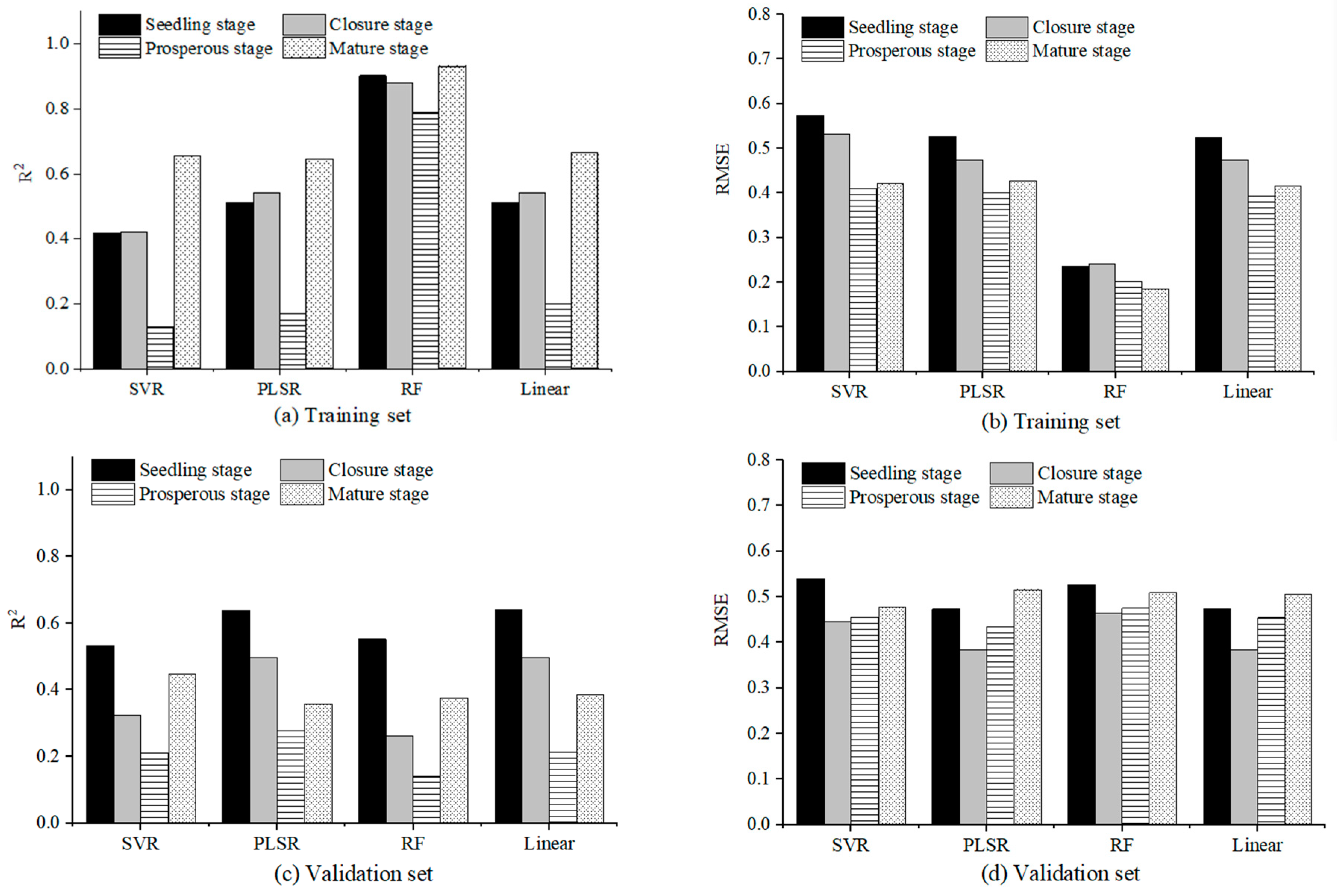

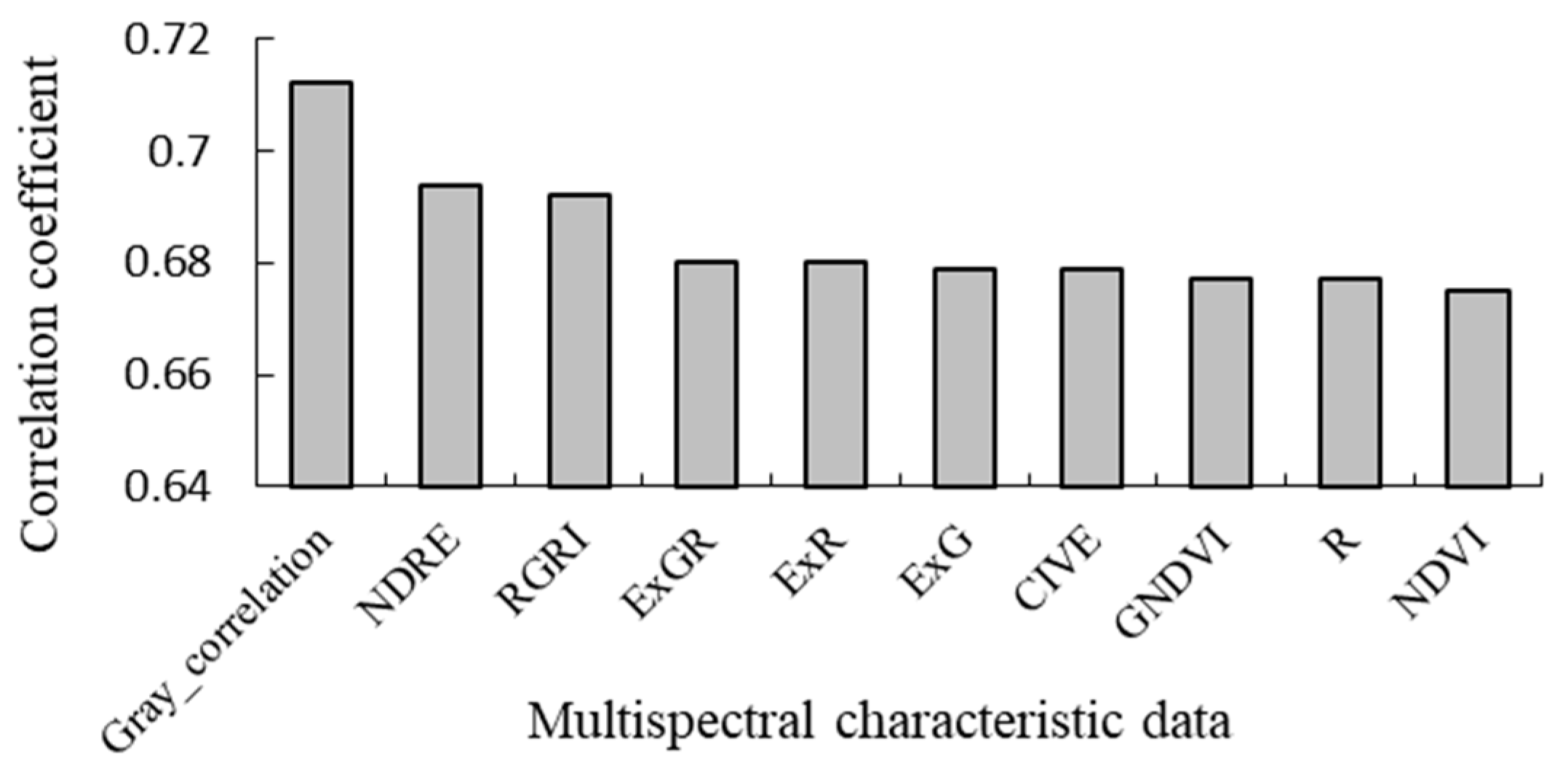
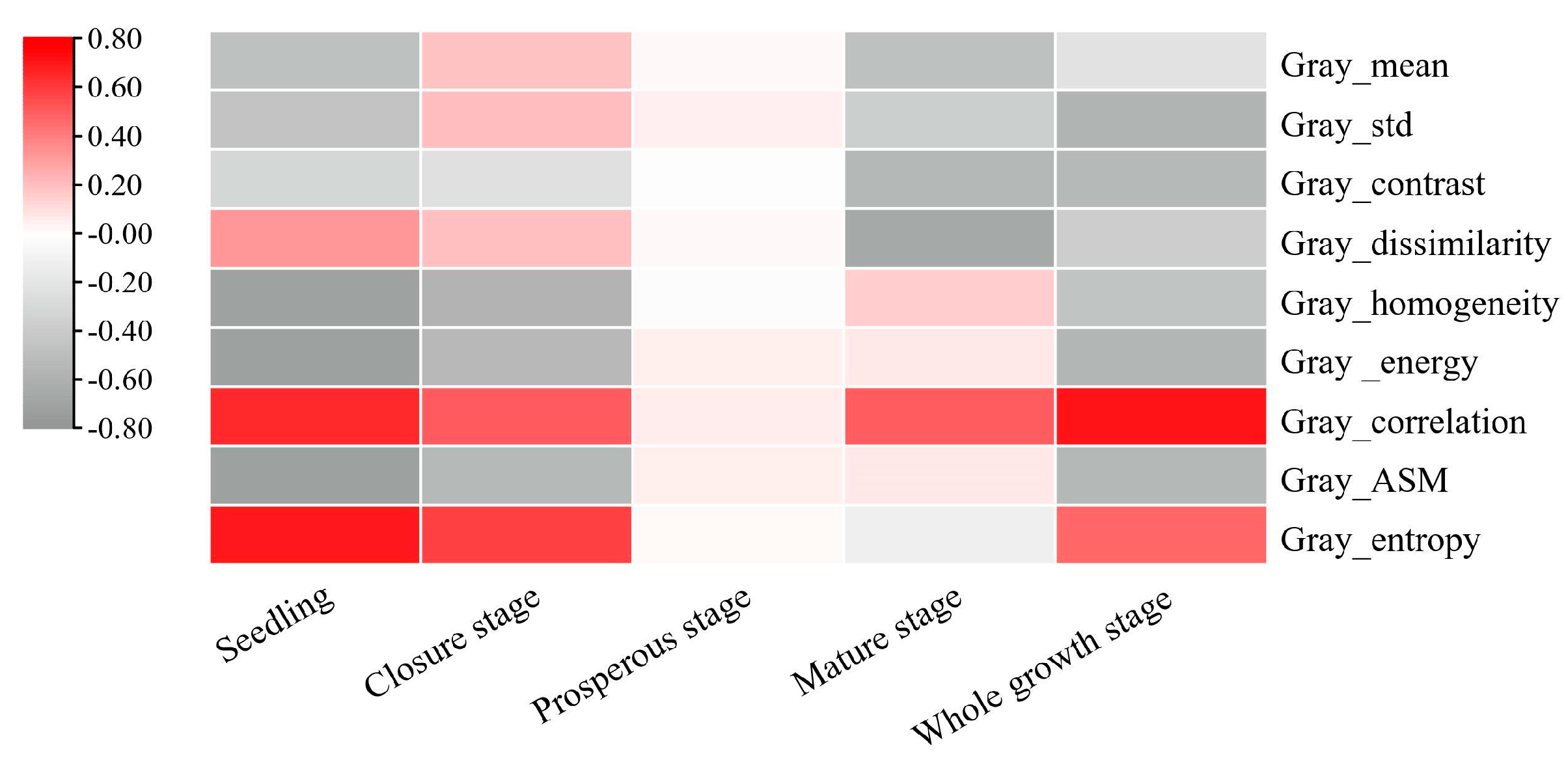
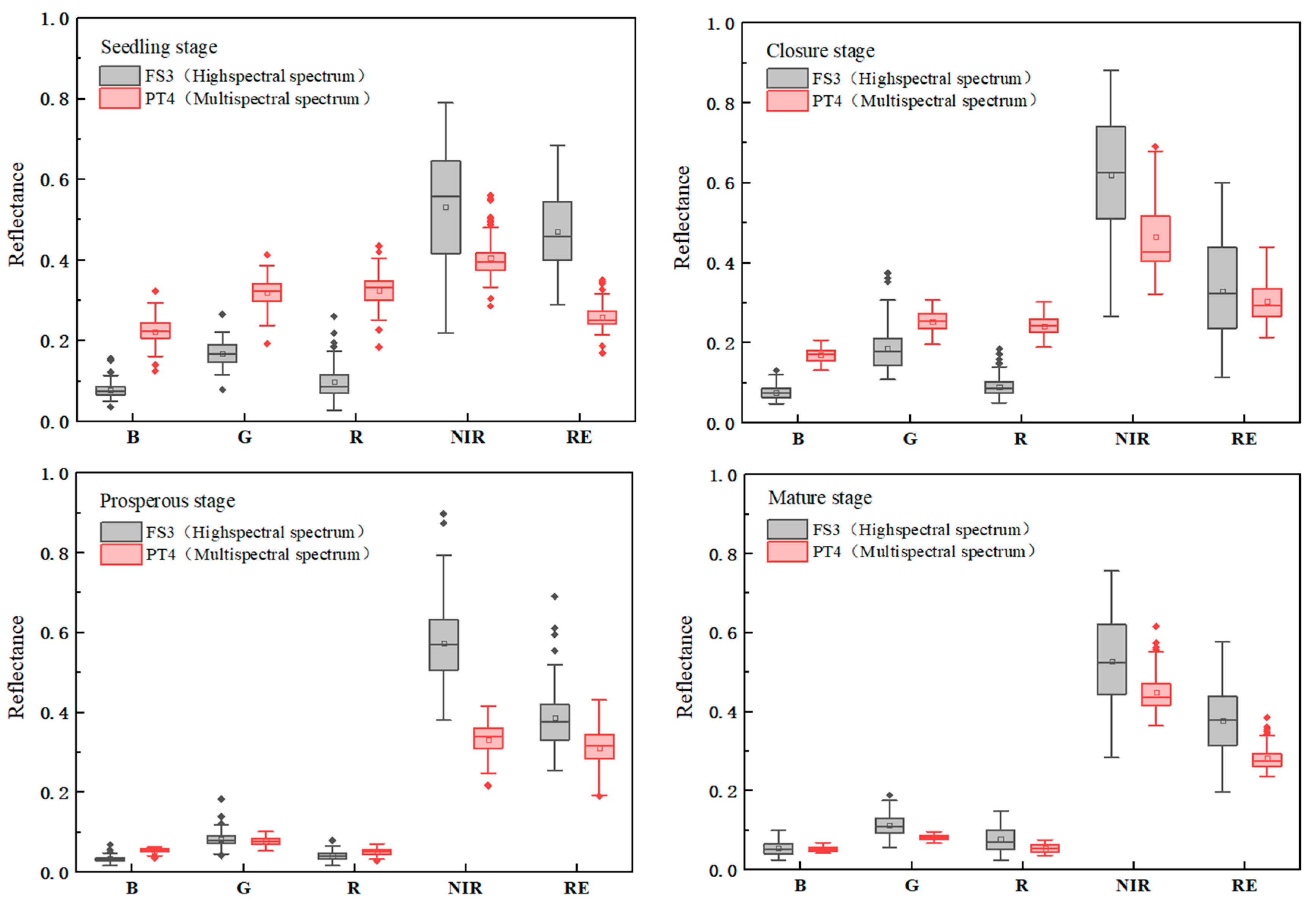
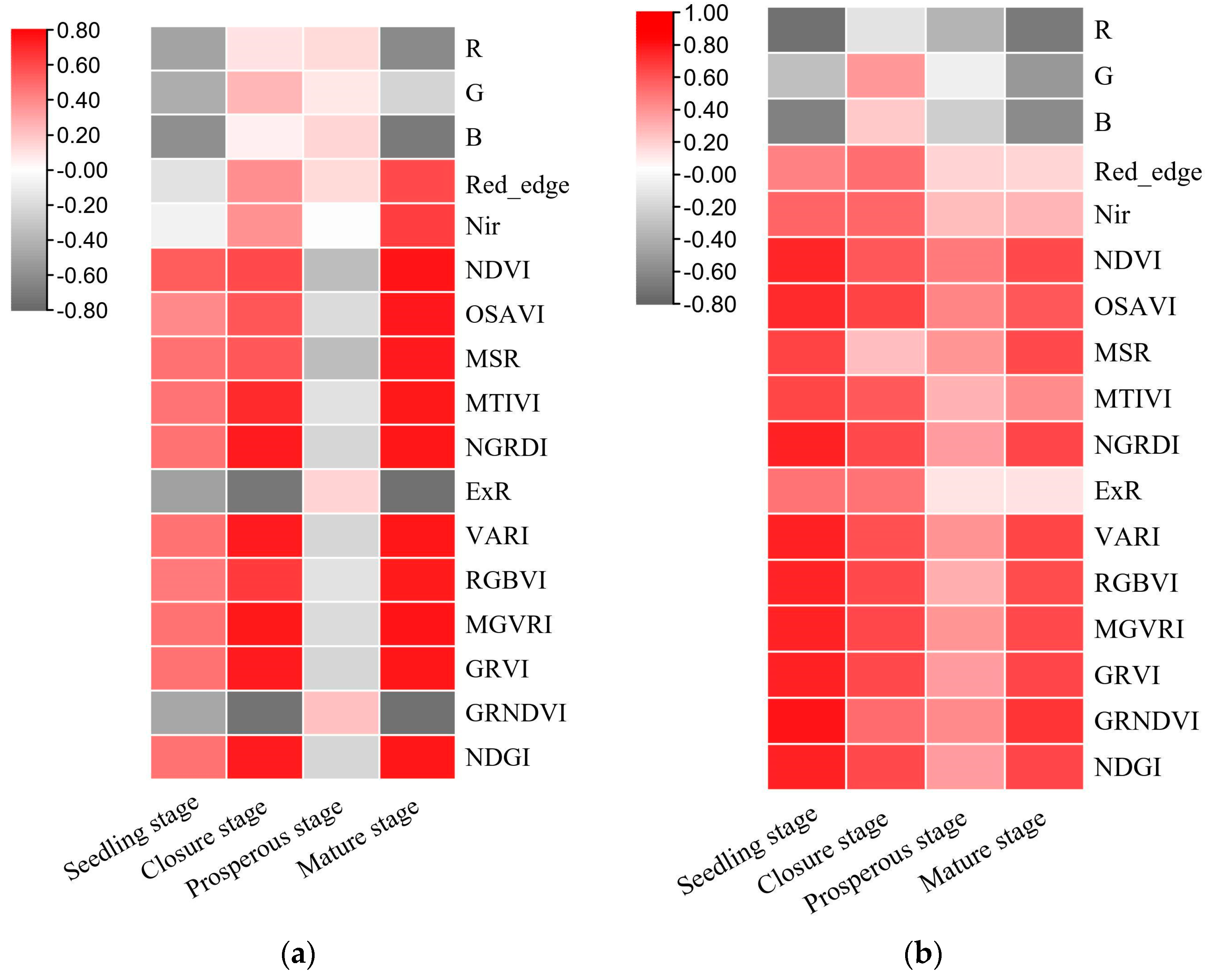
| Number | Band Name | Center Wavelength (nm) | Half Width (nm) |
|---|---|---|---|
| 1 | Blue band | 450 | 16 |
| 2 | Green band | 560 | 16 |
| 3 | Red band | 650 | 16 |
| 4 | Near infra-red band | 840 | 26 |
| 5 | Red-edge band | 730 | 16 |
| Stage | Number | Min (cm) | Max (cm) | Mean (cm) | CV (%) |
|---|---|---|---|---|---|
| Seedling stage | 76 | 0.91 | 4.21 | 2.39 | 32.21 |
| Closure stage | 76 | 1.17 | 4.31 | 2.83 | 23.29 |
| Prosperous stage | 76 | 2.57 | 5.19 | 4.29 | 10.85 |
| Mature stage | 76 | 1.6 | 4.67 | 2.97 | 23.75 |
| Whole-growth stage | 304 | 0.91 | 5.19 | 3.36 | 26.85 |
| Model | Training Set | Validation Set | ||
|---|---|---|---|---|
| R2 | RMSE | R2 | RMSE | |
| SVR | 0.614 | 0.649 | 0.608 | 0.629 |
| PLSR | 0.616 | 0.648 | 0.620 | 0.620 |
| RF | 0.944 | 0.248 | 0.702 | 0.548 |
| Linear | 0.656 | 0.613 | 0.657 | 0.589 |
| Model | Training Set | Validation Set | ||
|---|---|---|---|---|
| R2 | RMSE | R2 | RMSE | |
| SVR | 0.794 | 0.437 | 0.794 | 0.439 |
| PLSR | 0.786 | 0.446 | 0.784 | 0.449 |
| RF | 0.964 | 0.182 | 0.816 | 0.414 |
| Linear | 0.937 | 0.242 | 0.555 | 0.645 |
| Stage | Sensor | Training Set | Validation Set | ||
|---|---|---|---|---|---|
| R2 | RMSE | R2 | RMSE | ||
| Seedling stage | FS3 | 0.606 | 0.472 | 0.754 | 0.391 |
| PT4 | 0.566 | 0.455 | 0.708 | 0.467 | |
| Closure stage | FS3 | FS3 | 0.505 | 0.321 | 0.446 |
| PT4 | PT4 | 0.376 | 0.645 | 0.396 | |
| Prosperous stage | FS3 | 0.340 | 0.357 | 0.472 | 0.372 |
| PT4 | 0.298 | 0.368 | 0.072 | 0.493 | |
| Mature stage | FS3 | 0.578 | 0.469 | 0.243 | 0.562 |
| PT4 | 0.498 | 0.453 | 0.677 | 0.461 | |
| Whole-growth stage | FS3 | 0.944 | 0.228 | 0.723 | 0.508 |
| PT4 | 0.694 | 0.533 | 0.741 | 0.492 | |
| Model | Training Set | Validation Set | ||
|---|---|---|---|---|
| R2 | RMSE | R2 | RMSE | |
| SVR | 0.826 | 0.402 | 0.787 | 0.446 |
| PLSR | 0.819 | 0.819 | 0.808 | 0.423 |
| RF | 0.966 | 0.179 | 0.828 | 0.400 |
| Linear | 0.958 | 0.199 | 0.433 | 0.728 |
Disclaimer/Publisher’s Note: The statements, opinions and data contained in all publications are solely those of the individual author(s) and contributor(s) and not of MDPI and/or the editor(s). MDPI and/or the editor(s) disclaim responsibility for any injury to people or property resulting from any ideas, methods, instructions or products referred to in the content. |
© 2023 by the authors. Licensee MDPI, Basel, Switzerland. This article is an open access article distributed under the terms and conditions of the Creative Commons Attribution (CC BY) license (https://creativecommons.org/licenses/by/4.0/).
Share and Cite
Fu, H.; Chen, J.; Lu, J.; Yue, Y.; Xu, M.; Jiao, X.; Cui, G.; She, W. A Comparison of Different Remote Sensors for Ramie Leaf Area Index Estimation. Agronomy 2023, 13, 899. https://doi.org/10.3390/agronomy13030899
Fu H, Chen J, Lu J, Yue Y, Xu M, Jiao X, Cui G, She W. A Comparison of Different Remote Sensors for Ramie Leaf Area Index Estimation. Agronomy. 2023; 13(3):899. https://doi.org/10.3390/agronomy13030899
Chicago/Turabian StyleFu, Hongyu, Jianfu Chen, Jianning Lu, Yunkai Yue, Mingzhi Xu, Xinwei Jiao, Guoxian Cui, and Wei She. 2023. "A Comparison of Different Remote Sensors for Ramie Leaf Area Index Estimation" Agronomy 13, no. 3: 899. https://doi.org/10.3390/agronomy13030899
APA StyleFu, H., Chen, J., Lu, J., Yue, Y., Xu, M., Jiao, X., Cui, G., & She, W. (2023). A Comparison of Different Remote Sensors for Ramie Leaf Area Index Estimation. Agronomy, 13(3), 899. https://doi.org/10.3390/agronomy13030899





